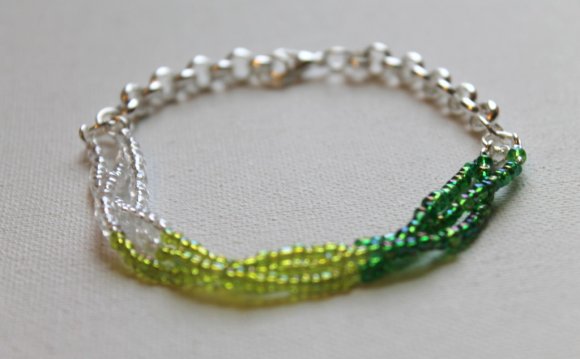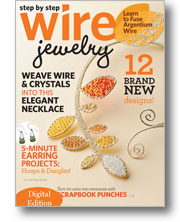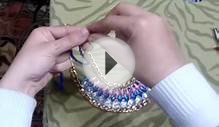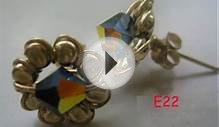
 By Tammy Jones, editor of Jewelry Making Daily
By Tammy Jones, editor of Jewelry Making Daily
I love how my eyes have been opened to the beauty and value of wire jewelry making since I began my job at . I didn't give handmade wire jewelry enough credit in the past; to me, making wire jewelry meant either wire-wrapped jewelry (which I didn't do) or making wire findings and other wire jewelry components. I didn't realize how important and widespread wire is in almost all jewelry making, not just wire-wrapped jewelry, until I saw the fun ways jewelry makers used wire in their wire jewelry patterns and designs.
Here are 7 essential wire jewelry tutorials, tips, and ideas for how to make wire jewelry:
1. Use the right wire jewelry-making tools:
- Nylon-jaw pliers are indispensable for straightening crimped or crumpled wire so that you can use it instead of tossing or recycling it. Good wire cutters will save your hands, especially when you're wire-wrapping loops or making other wire-wrapped jewelry. The right round-, chain-, needle- or flat-nose pliers can make repetitive or tedious tasks go more easily, and marking your spot on round-nose pliers can ensure consistently wrapped loops and eye pins, every time. The flat side of a ball-peen hammer will flatten and spread wire; the balled side will add dimples and texture to it. Rubber or nylon mallets will harden wire.
2.Go beyond wire wrapping stones: Wire jewelry making
- is more than how to wire wrap stones and other wire-wrapping techniques. With wire jewelry tutorials, you can learn to coil wire, make wire spirals, flatten wire, weave wire, knit or crochet wire, make chain maille weaves, solder and fuse wire into chain and other wire designs, make wire filigree, and more. Any of these techniques can produce wire jewelry and wire design elements that can enhance any jewelry design, including bead or metal designs.
3.Hardening and annealing wire:
- Wire is sold in hard, half-hard, or dead-soft varieties called "tensions." If you have one but need another, you can change it yourself! Tumbling or hammering with a nylon or rawhide mallet will harden dead-soft wire and wire designs; heating hard wire with a torch to anneal it will make it softer and easier to work with. If you make your own wire findings (and you should) like ear wires and clasps, hammer them with a rubber mallet after you've shaped them to make them harder, stronger, and help them maintain their shape. Soft wire will work harden as you manipulate it and might have to be annealed again. So knit, weave, or crochet with dead-soft wire; make findings with half-hard wire.
4.Make your own wire findings:
- It's easy, affordable, and cost-effective to
- , clasps, jump rings, balled or flat head pins, eye pins, and even wire chain. Form ear wires using a doubled-up, U-shaped wire (cut it in half later) on a Sharpie marker "mandrel" to ensure perfectly sized, perfectly matched ear wires every time. You can draw a ball on the end of silver or copper wire by holding it in a torch flame; later you can flatten the ball end by securing it in a vise and hammering it flat to make regular head pins. Knitting needles make great mandrels for making your own jump rings; saw the coil of wire into rings instead of cutting with wire cutters to ensure flush wire ends.
 5.Understand wire gauges:
5.Understand wire gauges:
- Wire gauge is a wire's diameter. The higher the number, the smaller the wire. Use 20-gauge wire to make ear wires (18 can be too large for some people and 22 gauge won't hold its shape). Make head pins using 18- to 24-gauge wire in general, though the holes of the beads you're using will determine the size of head pins you need. Pearls usually require smaller gauge wire. For jump rings, just about anything goes, depending on the project, but 18- to 22-gauge is most common. If you use a finer gauge (higher than 22), they won't be stiff enough to be very secure. Larger gauge (lower than 18) can be too big for most projects. To make hook-and-loop or S-hook clasps, 14- to 18-gauge wire is required. If you use a finer gauge (20 or higher), you'll need to harden them by hammering or tumbling so they'll keep their shape.
6.Organize your wire types, tensions, and gauges:
- If you think you can tell a piece of 20-gauge soft silver-plated wire from a piece of 22-gauge half-hard sterling silver wire just by looking, then ignore this tip! But if you're like me and you don't want to guess, store your wire in an accordion file from the office supply shop and label each piece or section with gauge, tension, and composition. You could also note the source, in case you want to buy more from the same place. Keeping the wire inside plastic bags will also cut down on tarnish.
RELATED VIDEO











